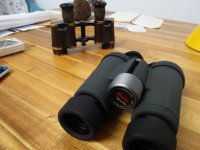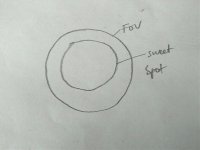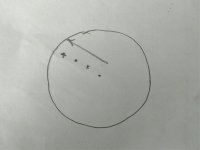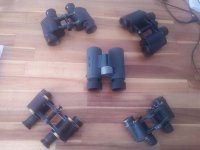Got this pair of binos in the morning. Here's my impression after day 1. For my eyes, my taste, and my particular sample.
Positive:
- 10 degree TFOV is GREAT. This strucks you immediately
- simple but beautifully looking binos.
- "Made in China" is printed on the body. Thanks Kowa for the openess
- CA nothing to worry about
- perfect collimation
Neutral:
- almost everything says "China". the play in the focuser. the sloppy eye cups. and the image! hard to describe. but it's the feel. central sharpness, edge sharpness (or the lack of it), the smoothness of the image, the overall aesthetics of the image, are unevenly distributed across the FOV. having extensive experience with budget Chinese optics, I noticed this immediately. Any old Zeiss or Leica or Swarovski will be superior in this aesthetic aspect, no matter how bleak their images are.
Negative:
- edge sharpness. more than I expected. about 2/3 of the FOV from center when it becomes blurry. Worst is that, the blur is more on the right and at the bottom than in the other directions (to be fair I have seen things like this in other superwidefield binos such as the Komz 6x24 and Bushnell Rangemaster 7x35). I know it is 10 degree FOV and any complaint on edge sharpness should be reasonable, but it is still a bit much to me. I did not notice this in the first few minutes, when I was still overwhelmed by the wide FOV. But once I noticed it, it can't be ignored.
So conclusion:
- Thanks Kowa for offering this. I hope this is a push towards an alpha 6x30 some day
- it is an interesting pair of binos. but quality is no more than 400USD price. its quality is not a bargain for the price. optics-wise, i think $300 is more reasonable.
- if you have to have a 6-7x wide-field pair of binos, then you might get it. But if you can live with 8x, get a Nikon E2 8x30. For less than $100 more (at least for where I live), the Nikon E2 is much much better: the look, the built, the feel, the image. it is the ultimate small and wide-field binos in my opinion.
In the photo are the Kowa and my 1908 CZJ Telex 6x.
Positive:
- 10 degree TFOV is GREAT. This strucks you immediately
- simple but beautifully looking binos.
- "Made in China" is printed on the body. Thanks Kowa for the openess
- CA nothing to worry about
- perfect collimation
Neutral:
- almost everything says "China". the play in the focuser. the sloppy eye cups. and the image! hard to describe. but it's the feel. central sharpness, edge sharpness (or the lack of it), the smoothness of the image, the overall aesthetics of the image, are unevenly distributed across the FOV. having extensive experience with budget Chinese optics, I noticed this immediately. Any old Zeiss or Leica or Swarovski will be superior in this aesthetic aspect, no matter how bleak their images are.
Negative:
- edge sharpness. more than I expected. about 2/3 of the FOV from center when it becomes blurry. Worst is that, the blur is more on the right and at the bottom than in the other directions (to be fair I have seen things like this in other superwidefield binos such as the Komz 6x24 and Bushnell Rangemaster 7x35). I know it is 10 degree FOV and any complaint on edge sharpness should be reasonable, but it is still a bit much to me. I did not notice this in the first few minutes, when I was still overwhelmed by the wide FOV. But once I noticed it, it can't be ignored.
So conclusion:
- Thanks Kowa for offering this. I hope this is a push towards an alpha 6x30 some day
- it is an interesting pair of binos. but quality is no more than 400USD price. its quality is not a bargain for the price. optics-wise, i think $300 is more reasonable.
- if you have to have a 6-7x wide-field pair of binos, then you might get it. But if you can live with 8x, get a Nikon E2 8x30. For less than $100 more (at least for where I live), the Nikon E2 is much much better: the look, the built, the feel, the image. it is the ultimate small and wide-field binos in my opinion.
In the photo are the Kowa and my 1908 CZJ Telex 6x.
Attachments
Last edited:







